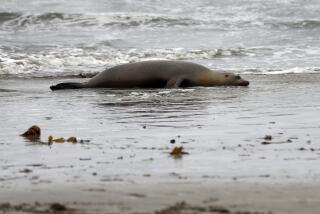Company Fires Animal Trainer Who Criticized Navy Program
- Share via
A marine mammal trainer who criticized the handling of dolphins and sea lions in a Navy program in San Diego has been fired from his job with a defense contractor for speaking to reporters about the matter, a Navy spokesman said Wednesday.
Trainer Rick Trout was fired about three weeks ago by Seaco, a San Diego company that has a Navy contract to train sea lions and dolphins for classified underwater reconnaissance and surveillance, said Tom LaPuzza, a spokesman for the Naval Ocean Systems Center in San Diego.
Talking to Media Banned
“The terms of his contract stated that he would not speak to the news media,” LaPuzza said, adding that Trout’s termination came shortly after he appeared on a local news show in San Diego.
In recent weeks, Trout has spoken to several reporters and has been harshly critical of the Navy’s program to use dolphins and sea lions in warfare.
He also objects to the fact that the animals are involved in life-threatening missions, but he said he is bound by law not to disclose details of those activities.
Attempts to reach Trout on Wednesday were unsuccessful, but in an interview with The Times last Friday, Trout said he was on a medical leave from Seaco and apparently was unaware that he had been fired.
“I am willing to go to jail for these animals,” Trout said. “What I am trying to expose is the futility of the whole project. I am not endangering our national security.”
A woman who answered the phone Wednesday at Seaco referred all calls about the matter to the Navy.
In a prepared statement issued Wednesday, the Navy denied Trout’s allegations and said it “does not mistreat” marine mammals.
“We maintain our marine mammals in accordance with the provisions of the Animal Welfare Act,” the statement said. “All training of marine mammals is based on positive reinforcement with food reward. Punishment is not used. Qualified veterinarians are present or on immediate call to provide both normal and emergency health care as required.”
Trout, who most recently worked with sea lions, alleged that the Navy purchases dolphins from a private contractor whose techniques are so poor that he drowns many while attempting to capture them. Further, the dolphins, which are caught off Mississippi, are immediately transferred to colder water off the Pacific coast and deprived of food, which causes the animals unnecessary stress, he said.
Trout also alleged that the dolphin-training program has been plagued by ineptitude, cost overruns, high turnover among employees and lengthy time extensions. The Navy began training 11 dolphins for the program in San Diego in 1984, but only six remain, he said, adding that the training was to have been completed in two years. Some swam away and others died, and none of the remaining dolphins are ready to perform the tasks required by the Navy, he said.
One of the dolphins died of pneumonia recently during an assignment in the Persian Gulf, Trout said.
Besides being deprived of food, the dolphins were muzzled for a time, Trout said. “You can’t keep control of them in the open ocean,” Trout said. “Dolphins are very social creatures.”
If the dolphins did not perform properly, their food was thrown out of their reach into a nearby pen, or was given to birds, he said.
Harnesses Linked to Deaths
Trout also said he objected to some aspects of the sea lion training program, particularly the use of harnesses to restrain the animals. All of the sea lions, which are captured on islands off the Pacific coast, are castrated and harnessed to make them easier to control, he said.
However, many of the sea lions escape by simply swimming away, he said. As the animals grow, the already snug-fitting harnesses become tighter and eventually cut into their skin and strangle them, causing painful and lingering deaths, he said.
Three sea lions have escaped from the San Diego program in the last nine months, he said, adding that the most recent escape involved a sea lion called Bruiser, who swam away from his trainers near Point Loma about four months ago.
“He’s been off for four months, and he loves to eat.”
The Navy made no attempt to locate or recapture Bruiser until recently, after a National Park Service ranger called Navy personnel to inform them that he had spotted a sea lion wearing a harness on San Miguel Island.
Animal handlers searched for Bruiser Oct. 24-28 but did not find him, LaPuzza said.
“They had no idea where he was until then.”
The search has been called off, but the Park Service rangers will continue to watch for Bruiser.
Changes Planned
In the meantime, sea lions in the program will be fitted with new harnesses made with straps that dissolve over time, LaPuzza said, adding that about 20% of sea lions swim away during the first six months of training.
More to Read
Sign up for Essential California
The most important California stories and recommendations in your inbox every morning.
You may occasionally receive promotional content from the Los Angeles Times.








